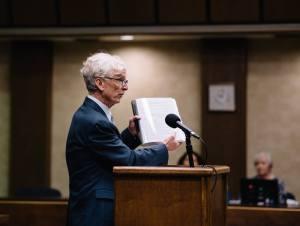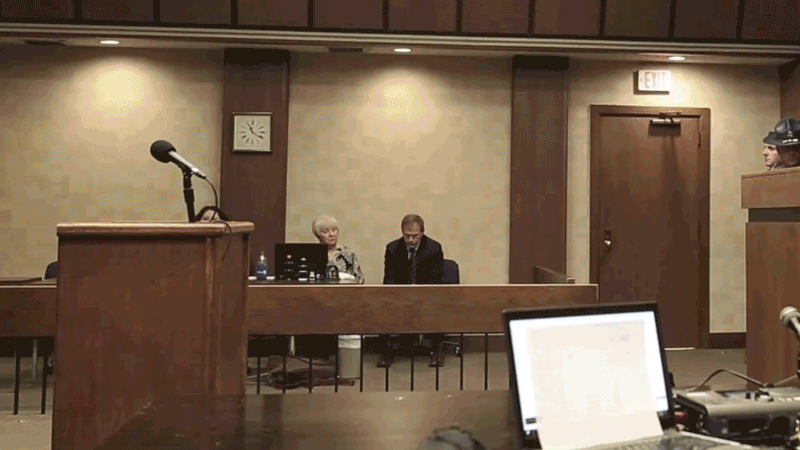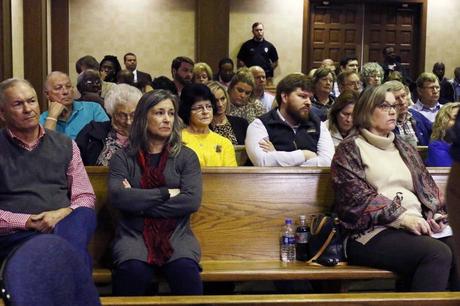I was fully aware that attorneys for Curtis Flowers had applied for bail, but I decided to skip the hearing in Winona, Mississippi.
 Rob McDuff makes his case
Rob McDuff makes his caseRob McDuff, the lead counsel for Mr. Flowers, had the law on his side. Since the 2010 conviction in trial number six had been vacated by the US Supreme Court, the legal record had been wiped clean. Legally, it was as if Curtis had never had his day in court and should therefore be granted the presumption of innocence. Having endured 23 years of incarceration without a single disciplinary write-up, Flowers didn’t constitute a flight risk.
But there was no way the State of Mississippi was going to grant bail to a man who had gone to trial six different times for killing four innocent people.
Besides, the man presiding at this bail hearing was Joseph (Joey) Loper, the man who had presided at four trials of Curtis Flowers in this same Winona courthouse.
When James Bibbs hung the jury in trial number five, Loper accused him of perjury and had him dragged from the courtroom in handcuffs.
During the sixth trial, when an African American intern working with the defense was stopped and harassed by a police officer, Judge Loper accused her of manufacturing her story and accused her of trying to turn the trial into “a theater of the absurd”.
Dismissing the bail hearing as a farcical formality, I stayed home.
Bad decision!
Not only did Loper release Flowers on bail, he rendered his decision because the state’s crucial witnesses had all recanted their trial testimony.
Then he castigated the State of Mississippi (represented in this case by District Attorney Doug Evans) for refusing to respond to defense motions. Evans hadn’t even shown up for the bail hearing, sending a subordinate with little familiarity with the Flowers case in his stead.
In short, Loper threw Evans under the bus. But why?
The issue that concerned the Supreme Court, racial bias during the jury selection process, had nothing to do with it. Loper has publicly stated that the Flowers case is about guilt and innocence, not black and white. He believed that in 2010 and he believes it today.
Loper’s decision to wash his hands of the Flowers prosecution is all about the evidence—or the lack thereof.
The state’s theory of the case had Curtis leaving his duplex apartment on foot, stealing a gun from the parking lot of the nearby Angelica garment factory, returning home for a brief spell, then walking to Tardy’s furniture store, murdering the owner, the business manager and two other employees execution style, and jogging home.
For each of these events the state had an eye witness.
Patricia Hallmon, Flowers’ next door neighbor, said she saw Curtis coming and going at times consistent with the state’s timeline.
Ed McChristian testified that he saw Curtis walking down the road to the Angelica factory.
Clemmie Fleming said she saw Curtis fleeing the scene of the crime on foot.
Most significantly, Odell “Cookie” Hallmon told numerous juries that Curtis admitted to the crime while both men were locked up together.
I doubt Loper would have left Evans twisting in the wind had he not listened to key protions of American Public Media’s In the Dark podcast. In the course of seventeen episodes, Patricia Hallmon, Ed McChristian, Clemmie Fleming and Cookie Hallmon all recant their trial testimony.
In the Dark also reduced the state’s forensic evidence to rubble by demonstrating, among other things, that the fleck of gunshot residue found on Mr. Flower’s right hand was meaningless, the gun allegedly stolen from the Angelica parking lot didn’t have to be the murder weapon, and that, contrary to what jurors had been told, the bloody shoe print found at the scene didn’t necessarily come from a size 10.5 running shoe.
Judge Loper had no direct connection to the evidence in the Flowers case—that was all on DA Evans and his lead investigator, John Johnson. Since the judge’s reputation wasn’t on the line, he was able to walk away.
It all makes sense in retrospect, but I didn’t see it coming.
Doug Evans, on the other hand, shows no signs of renouncing his handiwork. Interviewed by the In the Dark team the day following the bail hearing, Evans was defia
Thanks to In the Dark, Curtis Flowers now has thousands of supporters, most of whom are wondering why Doug Evans hasn’t been drummed out of office. Many would like to see Evans ensconced behind the bars of jail cell vacated by Curtis Flowers.
While understandable, these perceptions betray a fundamental misunderstanding of the social dynamics at work in this case. As I have argued elsewhere, Doug Evans shouldn’t be considered in isolation from his social context. He came of age in the heart of America’s most bitter civil rights struggle, a day in which white support for Jim Crow segregation was virtually unanimous in Mississippi. His professional career unfolded against a cultural backdrop in which white supremacy was just common sense.
The white people in Doug Evans’ jurisdiction don’t hate black people, they just believe that legislative and judicial decisions should be left in the hands of the legally constituted authorities. Doug Evans spent the better part of a year poring over the evidence in the Tardy murder case and if he thinks Curtis is the perpetrator who are we to disagree?
It’s easy to underestimate the sheer horror a mass murder produces in a little town like Winona. Murder is rare in small rural communities and largely restricted to the poor end of town. But two of the victims in the 1996 murder were leading members of the white community: Bertha Tardy, the proprietor, and her business manager, Carmen Rigby.
Another victim, Bobo Stewart, was a promising baseball prospect, just sixteen years old. Robert Golden, the fourth victim, was African American. A single crime wrapped an entire community in a blanket of grief and it fell to Doug Evans to produce a modicum of closure and justice.
In the Dark argues persuasively that at least four possible suspects were considered in the early days of the investigation.
Besides Curtis Flowers there was Doyle Simpson, the man who claimed his gun had been stolen on the very morning of the crime.
At least one witness had spotted Willie James Hemphill, a young man with a long list of violent crimes on his rap sheet, near the crime scene.
And then there was Marcus Presley, the sixteen year-old suspected of killing two Birmingham shop owners execution style in the days before and after the Tardy murders. Presley’s face even showed up in the photo array presented to one of the eye witnesses in the Winona case.
Significantly, Presley and Hemphill both wore Grant Hill Filas.
I have considered the alternate suspects in considerable detail elsewhere. Here I will focus on Doug Evans’ early decision to drop Simpson, Hemphill and Presley as suspects.
Evans knew the citizens of Winona were looking to him for closure and justice and he didn’t want to disappoint them. In the absence of a clear theory of the crime, wild and unwarranted rumors were beginning to circulate. The community wouldn’t relax until people were confident that Evans was building a case against a single suspect.
Evans doubted he could make a convincing case against Simpson, Presley or Hemphill. Simpson had once worked at Tardy’s and knew the layout of the place, but lacked a motive and had no history of violence. Presley and Hemphill had violent histories but there was nothing to tie them to the crime. All three drove cars and could have exited the scene without being observed.
Evans knew that 40% of the murders in America are never solved. He couldn’t let that happen to the worst crime in Winona history. A cold case would mean no resolution, no closure and no justice. It would also produce a toxic environment rife with speculation and finger-pointing.
Though it was rare for a Mississippi DA to be challenged at election time, if somebody wasn’t executed for the slaughter inside the Tardy furniture store, Evans feared his prosecutorial career would be brief.
Curtis Flowers became the sole suspect almost from day one because he was uniquely vulnerable to prosecution. He had worked at Tardy furniture for three days shortly before the crime. He had been fired by Bertha Tardy after failing to show up for work. And a check in his name was found on Bertha’s desk. An empty Grant Hill Fila shoe box was found in the bedroom closet of his home and he couldn’t remember with any precision or consistency what he had been doing the morning of the crime.
Most importantly, Curtis didn’t have a working automobile at his disposal. Investigators quickly concluded (incorrectly, it turns out) that Doyle Simpson’s gun had to be the murder weapon. Therefore, if Curtis did the deed, he would have had to walk from his home to the Angelica garment factory, return home on foot, then, an hour or so later, walk to the scene of the crime, murder four people execution style, and return home on foot.
Evans figured that if investigators canvassed the route Curtis walked that morning they would eventually find some eye witnesses. No single piece of evidence would be particularly compelling, but if it all pointed in the same direction a jury could be induced to convict.
But no eyewitnesses came volunteered for service and initial attempts to canvas the suspected route were not promising. Fortunately, John Johnson, Evans’ chief investigator, knew how to get people talking. By offering a $30,000 reward and issuing vague threats about what happened to people who refused to cooperate with the authorities, Johnson eventually lined up a dozen people willing to testify that they had spotted Curtis at the proper times and places. After a year of heavy-handed interviews, the evidence was in place.
Doug Evans and I have one thing in common, it didn’t take either of us long to make up our minds about Curtis Flowers.
After a few days interviewing neighbors and friends of the defendant I was convinced that Curtis couldn’t be the killer.
This wasn’t my first rodeo. In Tulia, Texas, Lafayette and Jena, Louisiana and Little Rock Arkansas, I had witnessed similar formula judicial scenarios. When the defendant is black, the prosecutor and the jury are white and the evidence is circumstantial you will almost always get a conviction. The fact that three juries had found Curtis guilty didn’t concern me.
The horrific nature of the crime was paramount. Whoever did the deed was either hardened by a long history of escalating violence or they enjoyed holding the power of life and death in their hands. The Winona killer was a tragically twisted individual, seething with hate.
If ever a person didn’t fit that profile it was Curtis Flowers. Even if he possessed a motive (which he didn’t), Curtis was temperamentally incapable of the crime.
The evidence in this case all pointed in the same direction because it was fake and fabricated.
Every last bit of it.
Observing the sixth trial from the black side of the courtroom while sleeping in Lola flowers guest bed and eating her wonderful cooking, simply enhanced my confidence. I understood why the folks on the white side of the courtroom. They didn’t know Lola and Archie Flowers. But they experienced a fresh jolt of anguish every time they remembered Bertha Tardy, Carmen Rigby, Bobo Stewart and Robert Golden and their heads nodded as they connected Doug Evans’ dots.
The trial unfolded with the inevitability of a Greek tragedy and as it drew to a conclusion I wrote the following:
The jury will almost certainly hand Curtis Flowers another death sentence. There is no big surprise here. We were hoping for a better result, but when a jury of eleven whites and one black was selected the writing was on the wall. That’s okay; every successful campaign Friends of Justice has launched began with a conviction (sometimes several). This case is simply too weak to stand. So enjoy the party while it lasts, Winona; brighter days lie ahead for Curtis Flowers and his loved ones.
I never dreamed it would take a full decade for Doug Evans deck of cards to collapse. My organization has turned around the occasional case on our won, but justice typically follows intense media attention and pro bono legal work. And that was particularly true in Winona.
I find myself asking where Curtis would be if In the Dark hadn’t picked up his story. Investigative reporting is exceedingly rare. There is simply no precedent for a team of intrepid journalists taking up residence in an isolated little town for over a year, interviewing key participants four or five times and tracking down every last sliver of evidence.
Their work deserves all the accolades it has received!
But Doug Evans and the white residents of Winona will never admit defeat. In their eyes, Curtis will always be guilty.
Emotionally, they equate abandoning the case Evans invented with abandoning the murder victims.
They see this episode as just another culture war battle in which “the liberals” can’t get a win. (Even Joey Loper is now derided as a “liberal”.)
They figure that the recanting witnesses are just weak people succumbing to interference from outside agitators.
They think of themselves as free thinking individualists, and resent being cast as impressionable rubes in the public eye.
They admire Doug Evans for his service to their cause.
Which is why the DA will never admit defeat and Curtis Flowers may never be safe to walk the streets of Winona, Mississippi as a free man.
But these sober facts can’t diminish the joy of watching Curtis Flowers walking out of the courtroom as a free man. A thrill of hope, a weary world rejoices!


